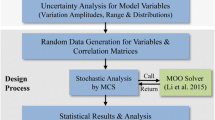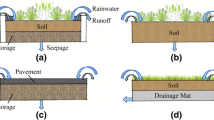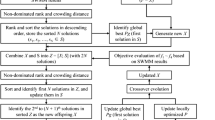Abstract
Detention tank plays an important role in the flooding control in the downstream areas of the urban stormwater drainage system (USDS) during the wet weather seasons. For complex watersheds with specific local flooding control policies, the conventional optimization and design methods are found to be not sufficient for effectively and optimally locating and sizing appropriate detention tanks any more. This paper investigates the optimal design of detention tanks under the constraints of local flooding control criteria, with the aim to develop an efficient and robust method and framework for the design of detention tank network. Coupled with the SWMM-based hydraulic simulation, a modified particle swarm optimizer is adopted to find out non-dominated solutions to minimize both the engineering cost and flooding risks by taking the local design criteria into consideration for the more realistic local engineering application. To validate the proposed method, a real-life case in SA city in China is taken for example to obtain optimal layout and sizes of the detention tank network under different construction factors and design conditions. Different rainfall return periods are also tested to guarantee the robustness of the optimal solutions. The results of this study confirm the feasibility and validity of the proposed methodological framework for multi-objective optimal design of detention tanks in the USDS.




Similar content being viewed by others
References
Balistrocchi M, Grossi G, Bacchi B (2013) Deriving a practical analytical-probabilistic method to size flood routing reservoirs. Adv Water Resour 62:37–46
Bennett MS, Mays LW (1985) Optimal design of detention and drainage channel systems. J Water Resour Plann Manage 111(1):99–112
CDOWE (Code for Design of Outdoor Wastewater Engineering) (2014) The People’s Republic of China Ministry of Housing and Urban Rural Development: 12–28
Chang CH, Wen CG, Lee CS (2008) Use of intercepted runoff depth for stormwater runoff management in industrial parks in Taiwan. Water Resour Manag 22(11):1609–1623
Deb K, Agrawal S, Pratap A, Meyarivan T (2000) A fast elitist non-dominated sorting genetic algorithm for multi-objective optimization: NSGA-II. Lect Notes Comput Sci 1917:849–858
Guo Y (2001) Hydrologic design of urban flood control detention ponds. J Hydrol Eng 6(6):472–479
Guo Y, Adams BJ (1999) An analytical probabilistic approach to sizing flood control detention facilities. Water Resour Res 35(8):2457–2468
Kamedulski GE, McCuen RH (1979) Evaluation of alternatives stormwater detention policies. J Water Resour Plann Manage, ASCE 105(WR2):171–186
Kennedy J, Eberhart R (1995) Particle swarm optimization. IEEE: 1942–1948
Li X (2003) A non-dominated sorting particle swarm optimizer for multiobjective optimization. In Genetic and Evolutionary Computation-GECCO 2003:37–48, Springer Berlin Heidelberg
Mays LW, Bedient PB (1982) Model for optimal size and location of detention. J Water Resour Plann Manage 108(3):270–285
Oxley RL, Mays LW (2014) Optimization–simulation model for detention basin system design. Water Resour Manag 28(4):1157–1171
Ramos HM, Teyssier C, López-Jiménez PA (2013) Optimization of retention ponds to improve the drainage system elasticity for water-energy nexus. Water Resour Manag 27(8):2889–2901
Rossman LA (2010) Stormwatrer management model user’s manual, version 5.0: water supply and water resources division. National Risk Management Research Laboratory, U.S. Environmental Protection Agency, Cincinnati
Rossman LA, Supply W (2006) Storm water management model, quality assurance report: dynamic wave flow routing. US Environmental Protection Agency, Office of Research and Development, National Research Management Research Laboratory
Sample DJ, Heaney JP, Wright LT, Fan C-Y, Lai F-H, Field R (2003) Costs of best management practices and associated land for urban stormwater control. J Water Resour Plann Manage 129(1):59–68
Shi Y, Eberhart RC (2001) Fuzzy adaptive particle swarm optimization. IEEE: 101–106
Sun F, Yang Z, Huang Z (2014) Challenges and solutions of urban hydrology in Beijing. Water Resour Manag 28(11):3377–3389
Tao T, Wang J, Xin K, Li S (2013) Multi-objective optimal layout of distributed storm-water detention. Int J Environ Sci Technol: 1–8
Travis QB, Mays LW (2008) Optimizing retention basin networks. J Water Resour Plann Manage 134(5):432–439
Tung YK (1988) Multi-objective detention basin design in urban drainage systems–tradeoff between risk and cost. Water Resour Manag 2(1):57–62
UNISDR (United Nations International Strategy for Disaster Reduction) (2012a) Number of climate-related disasters around the world (1980–2011) [online]. Available: http://www.preventionweb.net/files/20120613_ClimateDisaster1980-2011.pdf
Weiss JD, Hondzo M, Semmens M (2006) Storm water detention ponds: modeling heavy metal removal by plant species and sediments. ASCE J Environ Eng 132(9):1034–1042
Xu YP, Tung YK (2008) Decision-making in water management under uncertainty. Water Resour Manag 22(5):535–550
Yeh CH, Labadie JW (1997) Multiobjective watershed-level planning of storm water detention systems. J Water Resour Plann Manage 123(6):336–343
Zhang X, Hu M (2014) Effectiveness of Rainwater Harvesting in Runoff Volume Reduction in a Planned Industrial Park, China. Water Resour Manag 28(3):671–682
Acknowledgments
This work was financially supported by: (1) the Hong Kong Polytechnic University under research projects 1-ZCVD, G-UC73 and G-YBC9, and (2) the Tongji University under the project GYHY 201306055.
Author information
Authors and Affiliations
Corresponding author
Rights and permissions
About this article
Cite this article
Li, F., Duan, HF., Yan, H. et al. Multi-Objective Optimal Design of Detention Tanks in the Urban Stormwater Drainage System: Framework Development and Case Study. Water Resour Manage 29, 2125–2137 (2015). https://doi.org/10.1007/s11269-015-0931-0
Received:
Accepted:
Published:
Issue Date:
DOI: https://doi.org/10.1007/s11269-015-0931-0




